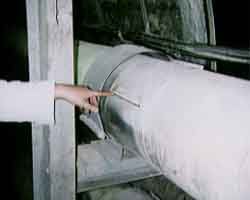| |
|
|
|
| |
|||
| |
|||
| |
|||
| |
|||
| |
|
|
|
|
| |
|
|
|
|
| |
|
|
| |
 |
 |
| |
Photo 1-11. Spider Guide Too Short (B-1050)
1-11. Spider guide in North B steam line pulled out of guide sleeve, presumably by unrestrained expansion due to broken anchor A-20. (B-1050) Importance of Guides: The critical stress to buckle a pipe is (per the Euler criteria for column failure) inversely proportional to the unrestrained length of the member squared. Guides on the 8” north D Steam Line are placed every 66 feet. If all the guides on this section have failed so the pipe is essentially unguided except for the end conditions, the force to buckle the pipe will drop by a factor of (325/66)^2= 24 times! This is why guides are critical to maintain pipe alignment. I calculate the critical force to buckle the 8” steam pipe in the north B Tunnel if all the guides have failed is only 5640 pounds*. In comparison, the frictional breakaway force required to get the expansion joint to contract is, via design calculation: 12,000 pounds. Thus the pipe will buckle rather than contract the expansion joint as it should during warm-up of the system. As the pipe member squirms out of alignment, the chances of the expansion joint hanging up increase. *(Fcrit = 4* (pi^2*E*I )/ L^2 where factor of 4 is for end conditions. |
|
All Rights Reserved | Kirsner Consulting Engineering
